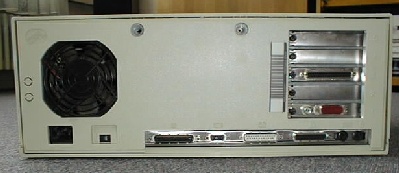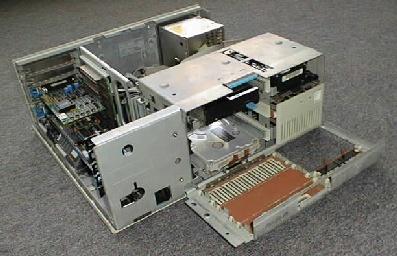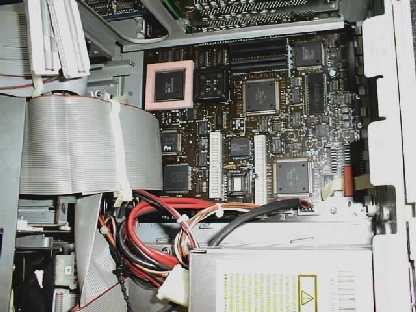
Click here or click onto the photo for a full size version of this picture.
After the 55SX, IBM brought a new line of PS/2s with a completely redesigned case. The different machines (386SX20...486DLC2/50 and later 486s) were packaged into two different cases, a smaller and a larger desktop (tower cases came back with the 85/90/95 server models later). The model 57 uses the larger case. In contrast to the 50/70, the case not only looks more solid, it even feels so: don't even think about carrying it around for a longer distance, the case is really heavy. I've never seen a case with back plate made of die-cast zinc before...
The CPU however wasn't a big improvement to its predecessor. A 386SX was low-end already at the time the 57SX was announced, and IBM quickly announced machine variants with 'enhanced 386SX' processors.
Apart from the standard PS/2 onboard peripherals, the model 56 and 57 feature a nice extension: an onboard SCSI controller was definitely not a standard component for PCs at that time.

Click here or click onto the photo for
a full size version of this picture.
The external SCSI connector is the leftmost long connector. Unfortunately, it is a nonstandard 60-Pin Mini Centronics connector, the same IBM also used in older RS/6000 workstations. Since the connector is so exotic, cables for it are rather expensive (about 120DEM here in Germany). Thankfully, the internal SCSI connector is a standard 50-pin ribbon connector...
The other connectors are PS/2-standard peripherals: VGA, serial, parallel, keyboard and mouse.

Click here or click onto the photo for
a full size version of this picture.
The 57 is not built as compact as the 56; even when all drive bays and slots are filled, there is still a lot of space behind the drive bays left. The planar board is the same as for the 56; I guess you could interchange mainboards between the 56 and the 57. The five Microchannel(tm) slots are oriented horizontally and the three SIMM slots are 45-degree types to make the modules fit under the bottommost expansion card. The SIMM slots accept an arbitrary mixture of 8M, 4M, and 2M boards, but of course you will never get more than 16Mbytes of RAM - the CPU cannot address more...
At the front, there is room for the floppy drive, two 5,25-inch, half-height drives and another 3,5-inch hard drive above the power switch. Though it seems there is unused space below this bay, there is not enough space for another drive; the 200W power supply extends almost to the front of the case. 5,25-inch drives are held via the typical rails screwed to the left and right of the drive, while a 3,5-inch drive is held by a special snap-in holder on the chassis' bottom. All drive's front covers are held in a common metal frame that can simply be snapped off (like in the next picture).

Click here or click onto the photo for
a full size version of this picture.
The power supply is DC-controlled, so the power switch is a low-voltage type; I haven't however found up to now a method to turn the machine on and off in software...).

Click here or click onto the photo for
a full size version of this picture.
I removed the floppy and SCSI cables to get a better view onto the main board (the other half on the other side of the raiser connector is less interesting since it only contains the SIMM sockets). A little mystery circumvents the two sockets for VRAM memory: You can put in another 256K of RAM (I did it in this machine), and IBM's test program in fact then reports the 512K video memory. I haven't found however any way to eploit the larger video memory.
- Processor:
- i386SX @ 20 MHz
- Coprocessor:
- Cyrix Cx83S87 @ 20 MHz
- Cache:
- none
- Memory:
- 16 Mbytes (options range from 4M to 16M)
- Bus:
- 5 MCA slots (16 bit)
- Interfaces (onboard):
-
- Mouse, Keyboard
- 1x Serial
- 1 x Parallel
- Floppy (2.88M), allows attachment of up to 3(!) drives
- SCSI (narrow)
- VGA (extendable to 512K VRAM ?)
- Add-on cards:
-
- SKnet Junior MC2 Ethernet Adapter
- AMS Parallel/Serial card
- Operating System(s):
-
- Linux 2.0 (Slackware-based)
- Useful Links: